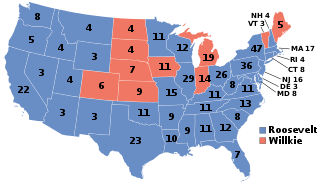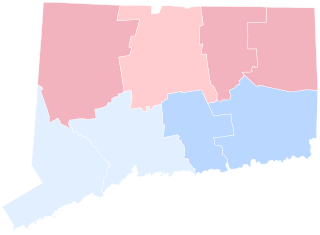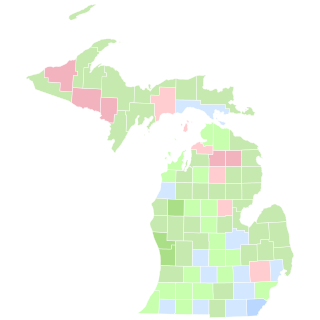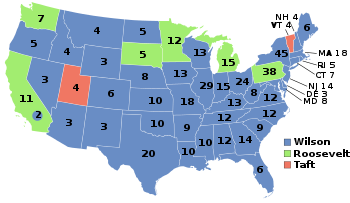
The 1912 United States presidential election was the 32nd quadrennial presidential election, held on Tuesday, November 5, 1912. Democratic Governor Woodrow Wilson of New Jersey unseated incumbent Republican President William Howard Taft while defeating former President Theodore Roosevelt and Socialist Party nominee Eugene V. Debs.

The 1912 Republican National Convention was held at the Chicago Coliseum, Chicago, Illinois, from June 18 to June 22, 1912. The party nominated President William H. Taft and Vice President James S. Sherman for re-election for the 1912 United States presidential election.

The Progressive Party was a third party in the United States formed in 1912 by former president Theodore Roosevelt after he lost the presidential nomination of the Republican Party to his former protégé turned rival, incumbent president William Howard Taft. The new party was known for taking advanced positions on progressive reforms and attracting leading national reformers. The party was also ideologically deeply connected with America's radical-liberal tradition.
The following table indicates the party of elected officials in the U.S. state of Maine:

The 1912 United States presidential election in Pennsylvania took place on November 5, 1912 as part of the 1912 United States presidential election. This was the first time that Arizona and New Mexico took part in a presidential election having been admitted to the Union earlier in the year. Voters chose 38 representatives, or electors to the Electoral College, who voted for president and vice president.

The 1940 United States elections was held on November 5. The Democratic Party continued to dominate national politics, as it defended its Congressional majorities and retained the presidency. It was the last election prior to the attack on Pearl Harbor and America's entry into World War II.

The 1912 United States presidential election in New York took place on November 5, 1912. All contemporary 48 states were part of the 1912 United States presidential election. Voters chose 45 electors to the Electoral College, which selected the president and vice president.

The 1912 United States presidential election in Massachusetts took place on November 5, 1912, as part of the 1912 United States presidential election, which was held throughout all contemporary 48 states. Voters chose 18 representatives, or electors to the Electoral College, who voted for president and vice president.

The 1916 United States presidential election in Vermont took place on November 7, 1916, as part of the 1916 United States presidential election which was held throughout all contemporary 48 states. Voters chose four representatives, or electors to the Electoral College, who voted for president and vice president.

The 1912 United States presidential election in Vermont took place on November 5, 1912, as part of the 1912 United States presidential election which was held throughout all contemporary 48 states. Voters chose four representatives, or electors to the Electoral College, who voted for president and vice president.

The 1912 United States presidential election in New Jersey took place on November 5, 1912. All contemporary 48 states were part of the 1912 United States presidential election. Voters chose 14 electors to the Electoral College, which selected the president and vice president.

The 1912 United States presidential election in Wisconsin was held on November 5, 1912 as part of the 1912 United States presidential election. State voters chose 13 electors to the Electoral College, who voted for president and vice president.

The 1912 United States presidential election in Ohio took place on November 5, 1912 as part of the 1912 United States presidential election. State voters chose 24 electors to the Electoral College, which selected the president and vice president.

The 1912 United States presidential election in Connecticut took place on November 5, 1912, as part of the 1912 United States presidential election which was held throughout all contemporary 48 states. Voters chose seven representatives, or electors to the Electoral College, who voted for president and vice president.

The 1912 United States presidential election in Maine took place on November 5, 1912, as part of the 1912 United States presidential election which was held throughout all contemporary 48 states. Voters chose six representatives, or electors to the Electoral College, who voted for president and vice president. Maine was won by the Democratic nominees, New Jersey Governor Woodrow Wilson and Indiana Governor Thomas R. Marshall. Wilson and Marshall defeated incumbent President William Howard Taft, and his running mate Vice President James S. Sherman and Progressive Party candidates, former President Theodore Roosevelt and his running mate California Governor Hiram Johnson.

The 1912 United States presidential election in Michigan took place on November 5, 1912, as part of the 1912 United States presidential election. Voters chose 15 representatives, or electors, to the Electoral College, who voted for president and vice president.

The 1912 United States presidential election in Arizona took place on November 5, 1912, as part of the 1912 United States presidential election. State voters chose three representatives, or electors, to the Electoral College, who voted for president and vice president. In Arizona, voters voted for electors individually instead of as a slate, as in the other states.

The 1912 United States presidential election in Kansas took place on November 5, 1912, as part of the 1912 United States presidential election. Voters chose ten representatives, or electors, to the Electoral College, who voted for president and vice president.

The 1916 United States presidential election in Arizona took place on November 7, 1916, as part of the 1916 United States presidential election. State voters chose three representatives, or electors, to the Electoral College, who voted for president and vice president.

The 1916 United States presidential election in Michigan took place on November 7, 1916, as part of the 1916 United States presidential election. Voters chose 15 representatives, or electors, to the Electoral College, who voted for president and vice president.





















